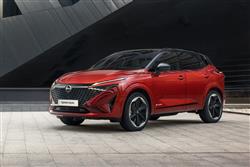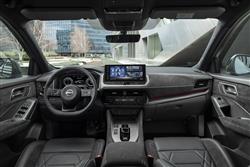POWER TO THE PEOPLE (some text hidden) --NONE--
By Jonathan Crouch
Nissan's Qashqai e-POWER features what might just be the mid-sized SUV segment's cleverest drivetrain. Jonathan Crouch drives the revised version.
Ten Second Reviewword count: 41
Nissan's Qashqai e-POWER offers a rather different stepping stone from combustion power to EV motoring. It's an interesting confection, always an EV yet also always petrol-powered. Who needs a hybrid? Here, we look at the now-smarter updated version of this model.
Backgroundword count: 120
Nissan calls the Qashqai e-POWER 'an electric car that you can fill up with petrol'. That sounds like a contradiction in terms doesn't it, but this powertrain really is difficult to classify. It can't be plugged in, but unlike a full-Hybrid, the engine never directly drives the wheels, its role instead being to power a front-mounted motor. Nissan calls this 'a bridging technology' that'll help transition customers to the full-EVs they'll have to live with in the future. And this powertrain will be key to the brand in achieving its targeted 50% electrification sales mix by 2030. The Qashqai e-POWER first arrived in 2022, then in Spring 2024 was updated to create the car we're going to look at here.
Driving Experienceword count: 188
It's a fascinating drivetrain this - and Nissan hasn't messed with it as part of the mid-term updates made to this third generation Qashqai design. For a start, at 2.1kWh in size, the battery is about twice the size it would be in a conventional full-Hybrid. And it's topped up by a little three cylinder Variable Compression 1.5-litre turbo petrol engine that never directly powers the wheels. Forward motion is instead taken care of by single front axle-mounted motor which puts out 190PS and 310Nm of torque. Which is enough to propel the Qashqai e-Power to 62mph from rest in 7.9s. Inevitably, it only works with auto transmission, but does so more smoothly than with the CVT autos used in some full-Hybrids thanks to a feature called 'linear tune' which ties engine speed to road speed. Nissan has also engineered in its 'i-Pedal' tech, which increases energy regeneration when you come off the throttle. This doesn't slow the car as much as it would with the company's LEAF and Ariya full-EVs, but it will mean that in normal motoring, you'll be using the brake pedal a lot less.
To see the full road test text contact us on 0330 0020 227
Pictures (high res disabled)
.jpg)
.jpg)
|
.jpg)
|
.jpg)
| |||
.jpg)
|
.jpg)
|

| |||
.jpg)
|
.jpg)
|
.jpg)
| |||
.jpg)
|

|
Statistics (subset of data only)
Min |
Max |
|
Price: |
£34,430.00 (At 12 Aug 2024) |
£42,980.00 (At 12 Aug 2024) |
Insurance group 1-50: |
30 |
32 |
CO2 (g/km): |
116 (Accenta Premium) |
119 (Tekna+) |
Max Speed (mph): |
105 |
|
0-62 mph (s): |
7.9 |
|
Combined Mpg: |
54.3 (Tekna+) |
55.4 (Accenta Premium) |
Length (mm): |
4425 |
|
Width (mm): |
1838 |
|
Height (mm): |
1635 |
|
Boot Capacity (l): |
500 |
|
Scoring (subset of scores)
Category: Hybrid, Plug-in, Electric & Hydrogen
| Performance | |
| Handling | |
| Comfort | |
| Space | |
| Styling, Build, Value, Equipment, Depreciation, Handling, Insurance and Total scores are available with our full data feed. | |



